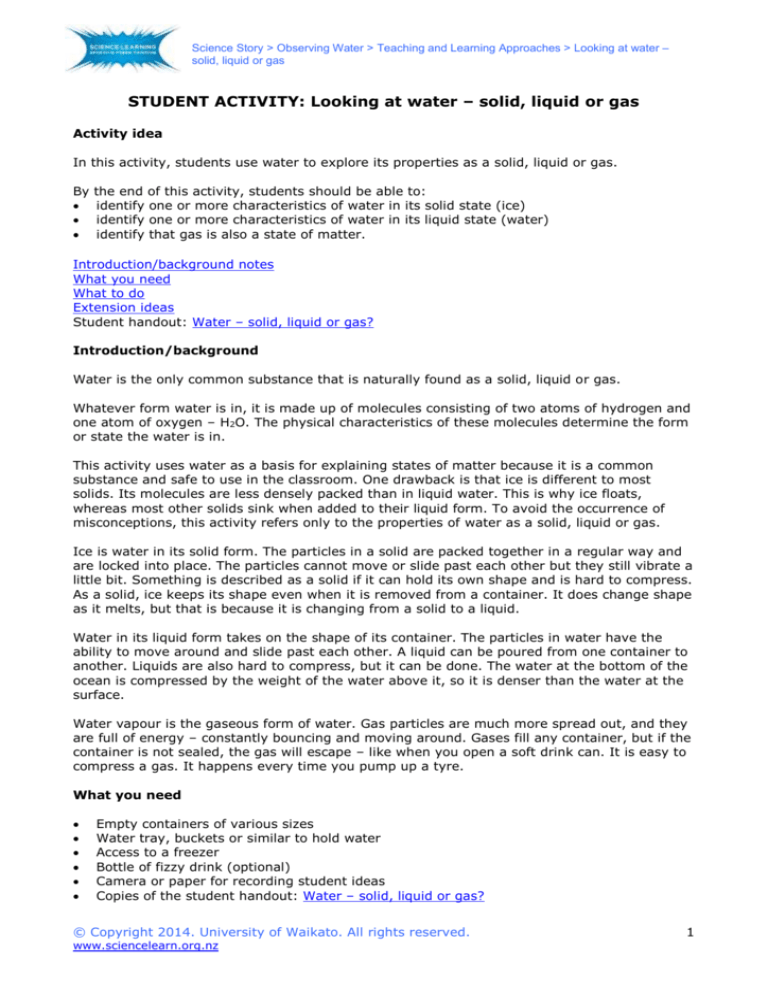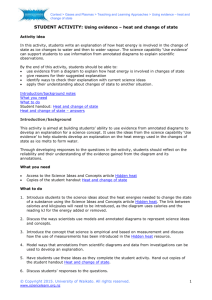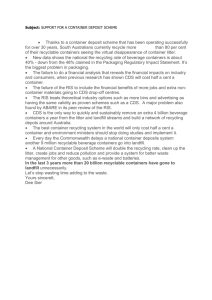
Science Story > Observing Water > Teaching and Learning Approaches > Looking at water –
solid, liquid or gas
STUDENT ACTIVITY: Looking at water – solid, liquid or gas
Activity idea
In this activity, students use water to explore its properties as a solid, liquid or gas.
By
the end of this activity, students should be able to:
identify one or more characteristics of water in its solid state (ice)
identify one or more characteristics of water in its liquid state (water)
identify that gas is also a state of matter.
Introduction/background notes
What you need
What to do
Extension ideas
Student handout: Water – solid, liquid or gas?
Introduction/background
Water is the only common substance that is naturally found as a solid, liquid or gas.
Whatever form water is in, it is made up of molecules consisting of two atoms of hydrogen and
one atom of oxygen – H2O. The physical characteristics of these molecules determine the form
or state the water is in.
This activity uses water as a basis for explaining states of matter because it is a common
substance and safe to use in the classroom. One drawback is that ice is different to most
solids. Its molecules are less densely packed than in liquid water. This is why ice floats,
whereas most other solids sink when added to their liquid form. To avoid the occurrence of
misconceptions, this activity refers only to the properties of water as a solid, liquid or gas.
Ice is water in its solid form. The particles in a solid are packed together in a regular way and
are locked into place. The particles cannot move or slide past each other but they still vibrate a
little bit. Something is described as a solid if it can hold its own shape and is hard to compress.
As a solid, ice keeps its shape even when it is removed from a container. It does change shape
as it melts, but that is because it is changing from a solid to a liquid.
Water in its liquid form takes on the shape of its container. The particles in water have the
ability to move around and slide past each other. A liquid can be poured from one container to
another. Liquids are also hard to compress, but it can be done. The water at the bottom of the
ocean is compressed by the weight of the water above it, so it is denser than the water at the
surface.
Water vapour is the gaseous form of water. Gas particles are much more spread out, and they
are full of energy – constantly bouncing and moving around. Gases fill any container, but if the
container is not sealed, the gas will escape – like when you open a soft drink can. It is easy to
compress a gas. It happens every time you pump up a tyre.
What you need
Empty containers of various sizes
Water tray, buckets or similar to hold water
Access to a freezer
Bottle of fizzy drink (optional)
Camera or paper for recording student ideas
Copies of the student handout: Water – solid, liquid or gas?
© Copyright 2014. University of Waikato. All rights reserved.
www.sciencelearn.org.nz
1
Science Story > Observing Water > Teaching and Learning Approaches > Looking at water –
solid, liquid or gas
What to do
1. Before beginning this activity, freeze water in small containers like yoghurt pottles,
margarine containers, balloons or similar so that the ice can be easily removed but is in a
variety of shapes.
2. Consider how you wish to conduct this activity:
It can be a structured, teacher-led activity with the opportunity for discussion between
each section.
Alternatively, consider setting up a water tray outdoors with several different-sized
containers for pouring. In a separate area, set up a table with the blocks of ice and the
containers in which they were frozen. Explain to students that they are scientists
investigating water and they need to experiment (rather than play) with the water and
the ice to learn more about its properties. Use the questions below to prompt student
understanding as the students experiment. Regroup to discuss findings and go through
the steps below to help consolidate learning discoveries students may have made.
3. Introduce the word ‘liquid’. Ask students to name liquids. What do they know about a
liquid’s properties or characteristics? Use some of the following questions for prompts:
What makes water a liquid?
What happens when you pour it from one container to another?
Does liquid have a shape?
What happens when you spill a liquid?
Can you squash (compress, not break or smash) a liquid?
4. Set up a water tray or similar and give students containers of various sizes. Explain that
they are scientists and they need to experiment with the water to either answer the
previous questions or to prove whether their answers are correct.
5. Introduce the word ‘solid’. Ask students to name solids and to discuss their properties or
characteristics as above. Use similar questions as those listed for liquids.
6. Give students the opportunity to handle the ice blocks and the containers in which they
were made. Students can experiment to answer the questions.
7. Introduce the word ‘gas’. This can be a difficult concept for younger students because
gases are usually invisible. Explain that gas has a scientific meaning – the state of matter
distinguished (or different) from the solid and liquid states. Discuss other meanings of the
word gas (petrol for cars, LPG for barbecue or camp stoves, natural gas for cooking or the
kind that makes kids giggle).
8. Ask students to take a deep breath and to breathe out. Have them do this several times
while holding their hand or a shiny item like a mirror, tablet or eyeglasses in front of their
mouths to catch the water vapour.
What is coming out of your lungs?
Is it a solid, liquid or gas?
Why does it feel damp?
What could you be breathing out as well as ‘air’?
Can you see anything coming out of your lungs?
Can you pour your breath?
Does it have a shape?
9. Hand out copies of the student handout Water – solid, liquid or gas? Assess whether
students can:
categorise water in its three states
describe one or more characteristics of water in its different states, for example, solid
water is hard, or water vapour is invisible.
© Copyright 2014. University of Waikato. All rights reserved.
www.sciencelearn.org.nz
2
Science Story > Observing Water > Teaching and Learning Approaches > Looking at water –
solid, liquid or gas
10. (Optional) Show the students a bottle of fizzy drink. Explain that it has a gas (carbon
dioxide) injected into the liquid to make it fizzy. Open the bottle to hear the gas escape.
Explain that a gas can be kept in a container but it will escape if the container is not
sealed.
11. Take photos of the student working with the solid ice, liquid water and either breathing out
or the bottle of fizzy drink. Write captions or bullet points of student ideas for a wall
display.
Extension ideas
Older students can explore the ability of a solid, liquid or gas to be compressed. Encourage
them to gather examples of solids and experiment with compression. For example, it will be
difficult to compress a block of wood or ice, but why can they compress a sponge when it is a
solid? Can they find a way to compress a liquid? (Hint – check out how hydraulic brakes work
in a car.) How can they compress a gas? (Hint – bike tyres, diving tanks, hydraulic lifts to raise
cars at garages.)
One of the characteristics of a liquid is that it can be poured from one container to another and
holds the shape of the container. Give students some dry sand or a bag of rice and some
containers. Ask them to come up with a list of reasons as to whether these are a solid or
liquid.
© Copyright 2014. University of Waikato. All rights reserved.
www.sciencelearn.org.nz
3
Science Story > Observing Water > Teaching and Learning Approaches > Looking at water –
solid, liquid or gas
Student handout: Water – solid, liquid or gas?
Cut out the pictures and place them in the correct category.
Solid
(Ice)
Liquid
(Water)
Gas
(Water
vapour)
Liquid water is _____________________________________.
Solid water is ______________________________________.
Water vapour is ____________________________________.
© Copyright 2014. University of Waikato. All rights reserved.
www.sciencelearn.org.nz
4
Science Story > Observing Water > Teaching and Learning Approaches > Looking at water –
solid, liquid or gas
Cut out the pictures and decide whether they are solid water, liquid
water or a gas – water vapour.
© Copyright 2014. University of Waikato. All rights reserved.
www.sciencelearn.org.nz
5










